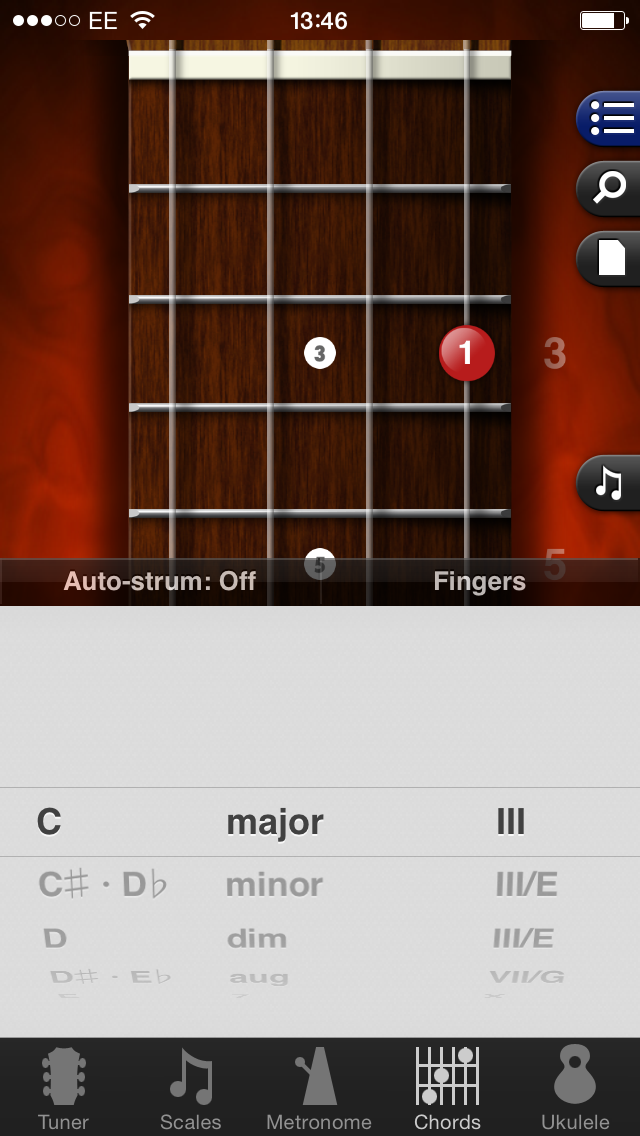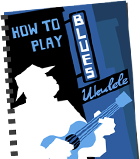The last time I reviewed ukulele chord finder apps back in 2010 I wasn’t that impressed. Time to find out if the situation has improved at all with a review of five apps that have been released since.
I’ve scored the apps out of 20 with five points available in each of these categories:
Chords: One point for each of these it passes:
C test: Pass if the A-string is fretted with the 3rd finger rather than the first finger.
Em test: Pass if g-string is played open rather than at the 4th fret.
Fmaj7 test: Pass if the default chord is playable (i.e. not 2413) and another point if 5500 is there at all.
C9 test: Pass if both C9 and Cadd9 chords are available and have playable default shapes.
Looks: This one is subjective but I give points if everything is clean and readable and it fits with the iOS 7/8 look.
Usability: Particularly how easy it is to select the root note of the chord, change flavour of the chord (whether it’s major, minor, 7 etc.) and switch between inversions.
Options: One point for each of these options it has: sound, left handed mode, D-tuning, baritone tuning, chord lookup (i.e. you can put in a chord shape and it’ll tell you the name).
Winner: Ukulele Toolkit
Ukulele Toolkit in the App Store
Overall Score: 19/20
A fantastic app. Very well thought out, helpful chord suggestions and looks great.
Price: $3.99/£2.99
Chords: 5 points
C test: Pass
Em test: Pass
Fmaj7 test: Pass with bonus point. 5500 is the default shape.
C9 test: Pass
Looks: 5 points
Easily the best looking app here. Everything is clean, easy to read and fits well with the iOS 8 look. The only thing I don’t like the look of is the app icon (a lot of EUMLab’s other app icons are much nicer).
Usability: 4 points
The chord section of the app is very good. You select the root note of the chord at the top of the screen and that brings up a cards showing all the different flavours of the chord. From there you can click on the expansion arrows on each card. That takes you to a page with a fretboard and the inversions of that chord.
The fingering suggestions are my only big gripe with the app. They’re off by default and I assumed they weren’t there at all until I found the option buried in the settings. With the setting on you get a cartoon hand with coloured fingers. The colours on the fretboard tell you which finger to use. I didn’t find it intuitive and quickly turned it back off.
A few minor niggles:
– The little expand arrows on the cards are a small tap target. I had trouble getting them open sometimes. My instinct was to press anywhere on the card to go to that screen.
– When a chord is played up the fretboard the diagram indicates the fret the chord starts on but still has the thick line at the top. The convention is to have a line the width of the frets to make it easier to spot that you’re up the fretboard.
– Because I wasn’t using the tuning option, I didn’t allow the app access to the mic. And it bugged me to allow it access every time I opened the app until I relented.
Features and Options: 5
Has all the options plus the option of a capo. It also has a metronome and tuner and other gubbins that aren’t part of this review.
UkeBank
Overall Score: 15/20
Price: Free with in app purchase ($2.99/£2.29) without the purchase only major, minor, 6 and m6 chords are available. So pretty useless without paying. But there are no ads in either version.
Chords: 3 points The most comprehensive app in terms of chord inversions and most of them are in the realms of playable. Some of the fingering suggestions could be better though.
C test: Fail.
Em test: Pass. Although slightly unusual in that the first inversion shown is 0402.
Fmaj7 test: Fail on the main test but a bonus point for showing 5500 (although it suggests barring the g and C-strings which seems unnecessarily tricky).
C9 test: Pass.
Looks: 4 points
Very good. Everything is clean, readable and pleasant to look at.
If I’m nitpicking, it is a bit of a jumble of textures at the bottom. There’s the flat white box, the slightly wood-grained wheel and the marbled box with grey text. But it didn’t bother me much.
Usability: 4 points
Unusually, it presents the chord names in a circle of fifths. That might be a little confusing for beginners but has the big advantage of having the chords you use together close to each other. I like it.
You change the flavour of the chord by clicking the square in the centre. That brings up a grid of options. The grid is laid out very well with most common chords at the top.
Features and Options: 4 points
There’s a left-handed mode and the sound is pretty good. It has C-tuning, D-tuning and baritone tuning. It actually goes a bit overboard on the tunings and lets you have the same tunings in soprano, concert and tenor (if there’s a difference I didn’t find it) and low-G tuning (which does change the sound but not the chord inversions). But there’s no chord lookup.
Guitar Toolkit
Guitar Toolkit in the App Store
Overall Score: 14/20
It’s a guitar centred app but also includes ukulele (and bass, banjo, mandolin). It’s a strong contender. If you’re a multi-instrumentalist it’s definitely worth considering.
Price: $3.99/£2.29
Chords: 1 point
It does suffer from being a guitar-focussed app. For exmpale, it includes slashes with the lowest note in the chord name.
C test: Fail.
Em test: Pass.
Fmaj7 test: Double fail.
C9 test: Fail. The default C9 is nuts. Mysteriously, it has Cmadd9 and C5add9 but not Cadd9.
Looks: 4 points
The app is more busy with the textures than Ukulele Toolkit (with a textured background, lighting effects on the fretboard dots and a busier fretboard). But it’s executed well and looks good.
Usability: 4 points
You select the chord using a three part wheel (one for the root, one for the flavour, one for the inversion). It feels a bit more clunky than some of the other methods but still easy to use.
Features and Options: 5 points
All the tunings plus the rarely used gCEG, decent sound and left-handed mode. Also has chord lookup.
UChord
Overall Score: 11/20
Price: Free with in app purchase ($3.99/£2.99). The free version has ads and has a restriction on the chord flavours shown (although you do get more flavours in the free version than you do with Uke Bank).
Chords: 2 Points
It does have the largest list of chord flavours of all these apps. To a fairly preposterous extent. If you’re the type of person who regularly has use for mM7-5 chords this is your app. But it’s a bit weak on the basics.
C test: Pass.
Em test: Fail.
Fmaj7 test: Double fail.
C9 test: Pass.
Looks: 3 points
It does look dated and I’m not a fan of the black and gold look. But the information is clear and it’s obvious what is what.
Usability: 3 points
There are two columns of buttons. One for the root and one for the flavour. Which would be great and I like the everything happens on one screen. But the order of the list of flavours in unfathomable to me. To get to the M7 and m7 chords you have to scroll a long way down the list past the likes of 13-5-9 and 9+11.
Features and Options: 3 points
No D-tuning or baritone tuning. The sound is okay and it has a left handed mode. It does have chord lookup but I’m only giving it the point reluctantly. It works by matching the chord symbols rather than by matching the notes. For example, because 0432 isn’t listed the app doesn’t recognise it as an Em chord.
Basichords
Overall Score: 10/20
It is that it’s the only app here that’s free without any feature restrictions. And it does have chords for many instruments including some that Guitar Toolkit doesn’t (like cavaquinho, bouzouki and mandola). It is useable if you’re absolutely set on not spending money.
Price: Free (with ads).
Chords: 2 points
C test: Fail.
Em test: Pass.
Fmaj7 test: Pass on the default chord (5453) but there’s no 5500.
C9 test: Fail. There’s no add9 chord.
Looks: 2
The app is still stuck in iPhone 4 size. So on anything more recent than that it has the black bars at the top and bottom of the screen. The text is pretty small. In general, it’s not a pretty app.
Usability: 3
Not too bad. You tap on a root note at the top then tap on list of flavours (no need for scrolling). The default chord shows at the top with other inversions on the right (you can select these to enlarge them). The text for the chord flavours is very small but other than that it works well.
It also has a “Vintage view” that uses wheels for chord selection. The advantage of this mode is that the text is much more readable.
Features and Options: 3 points
It has a left handed mode. Sound is there but it’s not great. There’s no baritone tuning or chord lookup. But it is the only app here that has a horizontal view.








I’m currently creating a cross-platform fretboard diagram designer called Chordious, which includes a chord and scale finder.
I know it’s not on iOS (yet) but the beta for the Windows desktop app has just started and I’d love any feedback you might have.
Thanks,
/jon